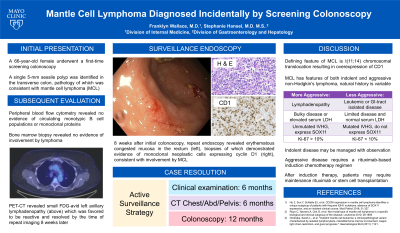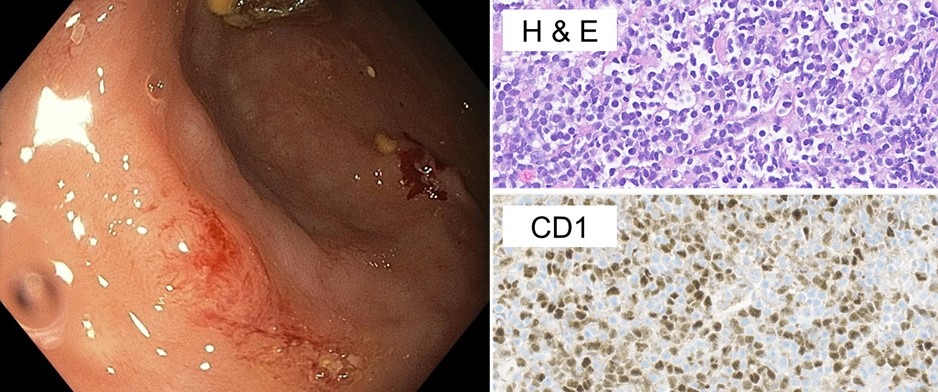Sunday Poster Session
Category: General Endoscopy
P0573 - Mantle Cell Lymphoma Identified Incidentally by Screening Colonoscopy
Sunday, October 22, 2023
3:30 PM - 7:00 PM PT
Location: Exhibit Hall

Has Audio

Franklyn Wallace, MD
Mayo Clinic
Rochester, MN
Presenting Author(s)
Franklyn Wallace, MD, Stephanie Hansel, MD, MS
Mayo Clinic, Rochester, MN
Introduction: Mantle cell lymphoma (MCL) is a rare mature B cell non-Hodgkin lymphoma caused by overexpression of cyclin D1 due to a chromosomal translocation t(11;14). Most commonly, MCL presents with late-stage disease characterized by widespread bulky lymphadenopathy, splenomegaly, and extranodal involvement (such as the GI tract or bone marrow). In a minority of cases, however, patients may present with disease limited to extranodal manifestations, which tend to have a more indolent course.
Case Description/Methods: A 66-year-old female with longstanding GERD presented for evaluation of dysphagia ongoing for the past three years. She had been suffering from daily heartburn for the past decade which was refractory to treatment with twice-daily proton pump inhibitors. For the past three years, she had progressively worsening solid-food dysphagia. An upper endoscopy performed locally revealed evidence of a hiatal hernia and evidence of mild gastritis/esophagitis.
Concurrently, she underwent colonoscopy for the purpose of colon cancer screening. A single 5 mm sessile polyp was identified and removed from the transverse colon. Histology revealed mantle cell lymphoma (MCL). The patient subsequently underwent a comprehensive staging evaluation. Peripheral blood flow cytometry revealed no evidence of circulating monotypic B cell populations or monoclonal proteins. Bone marrow biopsy revealed no evidence of lymphoma. PET-CT revealed small indeterminate FDG-avid lymph nodes in the neck and left axilla, but no definite evidence of lymphoma.
Eight weeks later, PET-CT was again without evidence of hypermetabolic lymphoma. On repeat colonoscopy, however, an area of congested mucosa in the rectum was biopsied and histopathology revealed evidence of involvement by MCL (Figure 1).
Clinically, she remains free from symptoms attributable to MCL. For now, she continues on active surveillance with PET/CT every three months and colonoscopy every six months.
Discussion: Management of mantle cell lymphoma depends heavily on the stage of disease and comorbid conditions. It is essential to differentiate nodal disease (which tends to be more aggressive) from disease which involves only the bone marrow or extranodal sites (which tends to be more indolent). Asymptomatic patients with extranodal disease alone can be managed with active surveillance via serial PET/CT and endoscopy. Patients with symptomatic or nodal disease require induction chemoimmunotherapy followed by autologous hematopoietic cell transplantation.

Disclosures:
Franklyn Wallace, MD, Stephanie Hansel, MD, MS. P0573 - Mantle Cell Lymphoma Identified Incidentally by Screening Colonoscopy, ACG 2023 Annual Scientific Meeting Abstracts. Vancouver, BC, Canada: American College of Gastroenterology.
Mayo Clinic, Rochester, MN
Introduction: Mantle cell lymphoma (MCL) is a rare mature B cell non-Hodgkin lymphoma caused by overexpression of cyclin D1 due to a chromosomal translocation t(11;14). Most commonly, MCL presents with late-stage disease characterized by widespread bulky lymphadenopathy, splenomegaly, and extranodal involvement (such as the GI tract or bone marrow). In a minority of cases, however, patients may present with disease limited to extranodal manifestations, which tend to have a more indolent course.
Case Description/Methods: A 66-year-old female with longstanding GERD presented for evaluation of dysphagia ongoing for the past three years. She had been suffering from daily heartburn for the past decade which was refractory to treatment with twice-daily proton pump inhibitors. For the past three years, she had progressively worsening solid-food dysphagia. An upper endoscopy performed locally revealed evidence of a hiatal hernia and evidence of mild gastritis/esophagitis.
Concurrently, she underwent colonoscopy for the purpose of colon cancer screening. A single 5 mm sessile polyp was identified and removed from the transverse colon. Histology revealed mantle cell lymphoma (MCL). The patient subsequently underwent a comprehensive staging evaluation. Peripheral blood flow cytometry revealed no evidence of circulating monotypic B cell populations or monoclonal proteins. Bone marrow biopsy revealed no evidence of lymphoma. PET-CT revealed small indeterminate FDG-avid lymph nodes in the neck and left axilla, but no definite evidence of lymphoma.
Eight weeks later, PET-CT was again without evidence of hypermetabolic lymphoma. On repeat colonoscopy, however, an area of congested mucosa in the rectum was biopsied and histopathology revealed evidence of involvement by MCL (Figure 1).
Clinically, she remains free from symptoms attributable to MCL. For now, she continues on active surveillance with PET/CT every three months and colonoscopy every six months.
Discussion: Management of mantle cell lymphoma depends heavily on the stage of disease and comorbid conditions. It is essential to differentiate nodal disease (which tends to be more aggressive) from disease which involves only the bone marrow or extranodal sites (which tends to be more indolent). Asymptomatic patients with extranodal disease alone can be managed with active surveillance via serial PET/CT and endoscopy. Patients with symptomatic or nodal disease require induction chemoimmunotherapy followed by autologous hematopoietic cell transplantation.

Figure: Figure 1: Congested mucosa in the rectum (left), biopsies of which revealed evidence of neoplastic B cells expressing cyclin D1, consistent with mantle cell lymphoma (right).
Disclosures:
Franklyn Wallace indicated no relevant financial relationships.
Stephanie Hansel indicated no relevant financial relationships.
Franklyn Wallace, MD, Stephanie Hansel, MD, MS. P0573 - Mantle Cell Lymphoma Identified Incidentally by Screening Colonoscopy, ACG 2023 Annual Scientific Meeting Abstracts. Vancouver, BC, Canada: American College of Gastroenterology.

